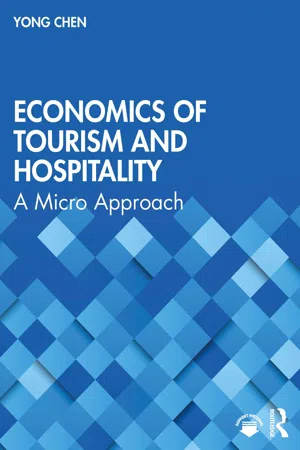
Economics of Tourism and Hospitality
A Micro Approach
Yong Chen
- 386 pages
- English
- ePUB (mobile friendly)
- Available on iOS & Android
Economics of Tourism and Hospitality
A Micro Approach
Yong Chen
About This Book
This book offers students an accessible and applied introduction to microeconomics in tourism and hospitality through a comprehensive analysis of the market mechanism, demand and supply, firm behavior and strategy, and transaction and institution.
This book not only helps students to master core microeconomic theories that are essential for understanding the tourism and hospitality industry, but, more importantly, it guides students to analyze consumer behavior and firm strategy specific to the industry. Throughout the book, readers are guided to develop the economic analysis of tourism and hospitality that progresses from economic intuition to graphical representation and to mathematical quantification. Carefully corralled case studies showcase the applications of key microeconomic theories in solving a wide range of real-world problems, including Uber's surge pricing, Airbnb's supply adjustment, and McDonald's and Burger King vying for prime locations. This book is written in an accessible style, illustrated with exquisite diagrams, and enriched with a range of other features, such as chapter summaries, review questions, and further readings to aid readers' further understanding.
By reading this book, students will be able to develop an economist's way of thinking, which will enable them to analyze tourism and hospitality businesses in a rigorous and critical manner. This book is essential reading for all tourism and hospitality students and teachers.
Frequently asked questions
Information
MODULE 1
The market
1 Economic approach to tourism and hospitality
We begin the economic analysis of tourism and hospitality by, first and foremost, providing an economic description of the industry from both demand and supply sides. On the one hand, we regard modern tourism as an economic phenomenon dating back to Thomas Cook’s tour operating business in England in the 1840s. On the other, the legitimation of tourism in the national economy depends on its contribution to gross domestic product (GDP), among others. The economic approach to tourism and hospitality allows us to elicit the demand and supply forces that drive the tourist economy and are subject to economic analysis. The economic description of tourism and hospitality is not only set up for this book, but applies to the tourism and hospitality industry as a whole insofar as the economic aspect of the industry is concerned. Throughout the book we shall adhere to the economic description outlined in this chapter, and analyze the key components of the industry for both demand and supply.
AFTER STUDYING THIS CHAPTER, YOU SHOULD BE ABLE TO:
- Understand what makes up modern tourism and hospitality;
- Describe the supply side of tourism and hospitality, referred to as the breadth and depth of the industry;
- Describe the demand side of tourism and hospitality, namely the tourist and the tourist economy; and
- Appreciate the economic significance of tourism at both national and international levels.
1.1 Tourism and hospitality
1.1.1 The making of modern tourism
[t]he major cost of each train trip was the coaling and the ‘steaming up,’ so the idea was to pack it with people... I now see no reason why a hundred may not travel together as easily as a dozen.5
1.1.2 The essence of hospitality
Table of contents
- Cover
- Half Title
- Title Page
- Copyright Page
- Dedication
- Table of Contents
- List of figures
- List of tables
- List of acronyms
- List of symbols
- Preface
- Instruction to readers
- Acknowledgments
- Module 1 The market
- Module 2 Demand
- Module 3 Supply
- Module 4 Firm behavior and strategy
- Module 5 Transaction and Institution
- Author Index
- Subject Index